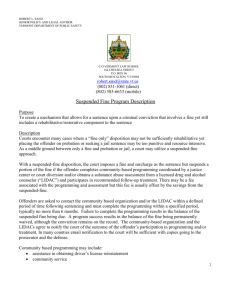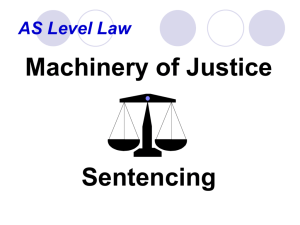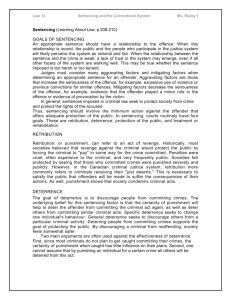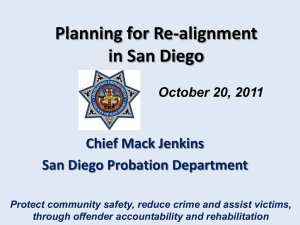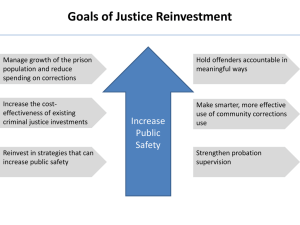CHAPTER 4
advertisement
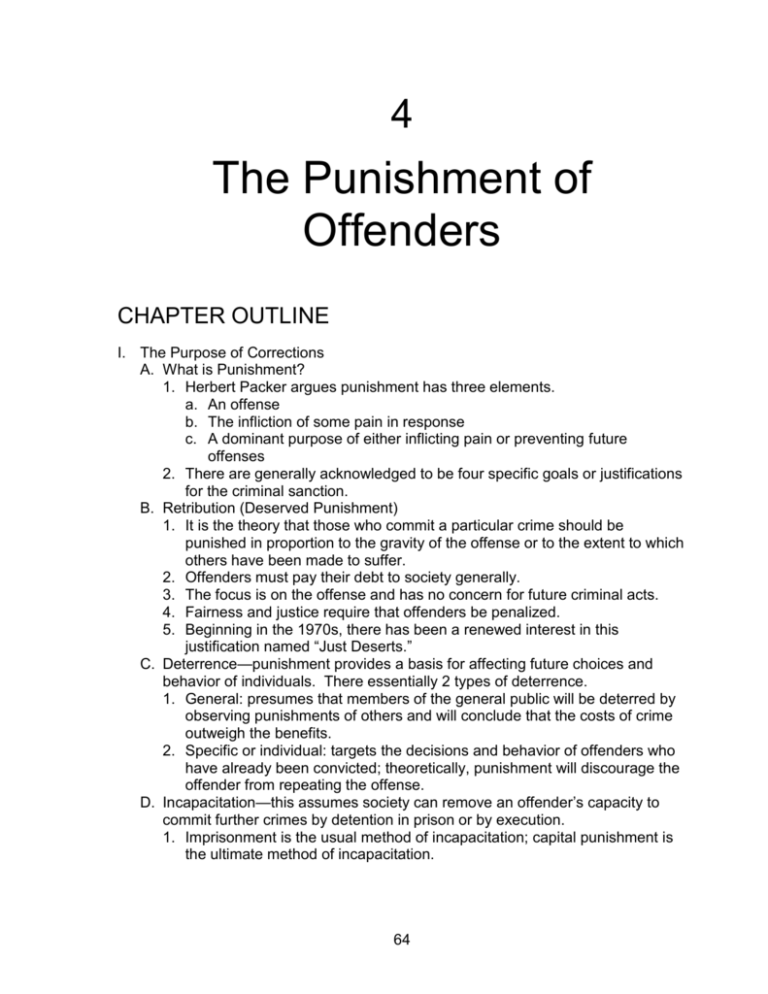
4 The Punishment of Offenders CHAPTER OUTLINE I. The Purpose of Corrections A. What is Punishment? 1. Herbert Packer argues punishment has three elements. a. An offense b. The infliction of some pain in response c. A dominant purpose of either inflicting pain or preventing future offenses 2. There are generally acknowledged to be four specific goals or justifications for the criminal sanction. B. Retribution (Deserved Punishment) 1. It is the theory that those who commit a particular crime should be punished in proportion to the gravity of the offense or to the extent to which others have been made to suffer. 2. Offenders must pay their debt to society generally. 3. The focus is on the offense and has no concern for future criminal acts. 4. Fairness and justice require that offenders be penalized. 5. Beginning in the 1970s, there has been a renewed interest in this justification named “Just Deserts.” C. Deterrence—punishment provides a basis for affecting future choices and behavior of individuals. There essentially 2 types of deterrence. 1. General: presumes that members of the general public will be deterred by observing punishments of others and will conclude that the costs of crime outweigh the benefits. 2. Specific or individual: targets the decisions and behavior of offenders who have already been convicted; theoretically, punishment will discourage the offender from repeating the offense. D. Incapacitation—this assumes society can remove an offender’s capacity to commit further crimes by detention in prison or by execution. 1. Imprisonment is the usual method of incapacitation; capital punishment is the ultimate method of incapacitation. 64 2. In recent years, greater attention has been paid to selective incapacitation. Offenders who repeat certain kinds of crimes are sentenced to long prison terms. E. Rehabilitation—refers to restoring a convicted offender to a constructive place in society through vocational or education training or therapy; offenders treated not punished. F. New approaches to punishing 1. With a renewed focus on community justice, some have called for “restoration” to be an added goal. 2. This views crime as an act that practically and symbolically denies community. The offender must take responsibility for the offense and agree to “undo” the harm and live according to the law. 3. The primary components of restorative justice a. Crime causes damage to relationships between community, offender, and victim. b. The offender must accept their responsibility for the injury. c. The offender must repair the damage and “restore” victim and community. d. The community is an actor in deciding how this will be accomplished, together with offender and victim. e. The community must seek to “reintegrate” the offender into the community in return for the repair, in order to prevent future offending. G. Criminal Sanctions: A Mixed Bag? Deterrence, incapacitation, retribution, rehabilitation; the justifications for specific sanctions overlap. II. Forms of the Criminal Sanction A. Incarceration: imprisonment is the most visible penalty imposed by U.S. courts, though fewer than 30% of all sentenced offenders are in prison or jail; 3 basic sentencing schemes are used. 1. Indeterminate 2. Determinate a. A specific length of time b. A presumptive sentence 3. Mandatory a. A mandatory minimum b. Three strikes 4. Disputes over time served a. Good time formulas b. Truth in sentencing i. Give the public more accurate sentencing information. ii. Force offenders to serving longer sentences, thus incapacitating them. iii. Make more rational allocation of prison space. B. Intermediate Sanctions—prison crowding and low levels of probation supervision have spurred interest in the development of these sanctions; less severe and costly than prison, but more restrictive than traditional probation. 65 1. Monetary sanctions 2. Home confinement 3. Intensive probation 4. Restitution 5. Community service 6. Boot camp 7. Forfeiture C. Probation—the most frequently applied criminal sanction; an offender serves a sentence in the community under supervision. 1. Offender serves time in community under supervision 2. 60% of adults under supervision are on probation. 3. Conditions are imposed specifying offender’s behavior while on probation. 4. If the conditions are not met, it can be revoked. 5. Shock Probation—specialized combination of short incarceration and probation; also known as split probation. D. Death—may have more significance as a political symbol than as a deterrent to crime. 1. The United States is the only Western democracy to employ this penalty. 2. As of January 1, 2004 there were 3,503 on death row in the United States. 3. Two thirds are in the South. 4. More significant as a symbolic issue than a deterrent against crime E. Forms and Goals of Sanctions— Incarceration, intermediate sanctions, probation, and death can each be used to achieve one or more punishment goals, though death is never capable of rehabilitation. III. The Sentencing Process A. The Administrative Context 1. Judges have responsibility for imposing sentencing in most cases. 2. Judges are significantly influenced by the context within which they impose sentences; differences are found between assembly-line style of misdemeanor courts and the more formal proceeding found in felony courts. 3. Two major types of courts a. Misdemeanor courts i. Assembly line justice ii. 90% of the criminal cases go through these courts. iii. Most punishments result in fine, restitution, community service or a combination. iv. Minor cases will be processed in volume in rapid succession. b. Felony courts i. Atmosphere is more formal due to the seriousness of the matters. ii. Ultimately shaped by relationships between the participants in the court B. Attitudes and Values of Judges—differences in sentencing can be explained in part by 1. Conflicting goals of criminal justice 66 2. Administrative pressures 3. Influence of community values 4. Judicial decisions also depend on personal attitudes towards a. The law b. A particular crime c. A type of offender 5. Martin Levin found that Pittsburgh judges, all of whom came from humble backgrounds, exhibited a greater empathy to defendants than did judges in Minneapolis who tended to come from upper-class backgrounds. C. The Presentence Report—an important ingredient in sentencing 1. The primary purpose is to help the judge select the sentence, but it also assists in the classification of probationers, prisoners, and parolees with respect to treatment planning and risk assessment. 2. Critics point out that PSIs are not scientific and often reflect stereotypes. 3. Because a substantial number of sentencing alternatives are open to judges, they often rely on the PSI for guidance. D. Sentencing Guidelines—designed to indicate to judges the expected sanction for particular types of offenses, intended to limit sentencing discretion and reduce the disparity for similar offenses. 1. They attempt to direct the judge to more specific actions that should be taken. 2. Legislatures, the federal government and commissions construct the guidelines as a grid of two scores; offender score is obtained by totaling the points allocated to the two factors. a. Criminal history b. Seriousness of offense 3. Judges may go outside the guidelines if aggravating or mitigating circumstances exist, but must provide a written explanation for it. 4. In Supreme Court rulings in 2003 and 2004, statutes which give the judge alone this authority have been declared unconstitutional. a. In the State of Washington, the statute was declared unconstitutional in whole in this regard. b. The federal sentencing guideline statute may now be considered only a “guide,” but unless a jury specifically finds a fact to exist, the court cannot contemplate it for sentence determination. IV. Sentencing Disparities A. The prison population in most states contains a higher proportion of African American and Hispanic American males than in the general population or in the population of arrested adults. B. Sentence disparity occurs when widely divergent penalties are imposed on offenders with similar backgrounds, committing the same offense, with no discernible or reasonable justification for the disparity. In short, the difference in sentences cannot be explained by “legal” factors, but only by “extra-legal factors (e.g., race). 67 C. The relationship between race and sentencing is a complex issue that involves many variables. V. Wrongful Convictions A. Little attention paid to this serious problem. B. Development of DNA testing has had profound consequences 1. Of 18,000 cases using DNA tests, more than 25 percent of the prime suspects were excluded from trail due to the lack of match. 2. In another study of 328 criminal cases, 199 were for murder and 120 were for rape. 3. The Innocence Project C. Why do they occur? 1. Eyewitness error 2. Unethical practices by police or prosecutors 3. Community pressure 4. False accusation 5. Poor counsel 6. Plea bargain pressures 68


